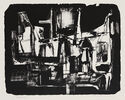
19th, 20th & 21st Century Fine Prints
707-546-7352 · fax 707-546-7924 · web: www.annexgalleries.com · email: artannex@aol.com
Albert W. Wein Biography
Albert W. Wein
American
1915–1991
Biography
Albert W. Wein, sculptor, painter, and printmaker, was born in the Bronx, New York on 27 July 1915. His mother, Elsa Meher Wein, was a portrait painter and a staff artist for the Baltimore-American. Wein studied at the Maryland Institute of Fine and Applied Arts. When his family moved to New York City, he studied at the Beaux-Arts Institute of Design with Sidney Waugh and at the Grand Central Art School. In 1931-32 he was enrolled at the National Academy’s school in the life class under Ivan Olinsky. Wein also studied at the Hans Hofmann School of Art.
From 1934 to 1942, Wein joined the rolls of the WPA's Federal Art Project and worked as a sculptor and painter. A wood relief created in 1942 titled Growth was installed at the post office in Frankfort, New York. He also worked in theater and television set design. In 1947, Wein was named a fellow of the American Academy in Rome and he won a Tiffany Foundation fellowship in 1949 which allowed him to travel and study in Europe and Greece. That same year, he participated in the Third Sculpture International exhibition held at the Philadelphia Museum of Art.
By the early 1950s, Wein was offered commissions for monuments and memorials, garden sculpture, architectural elements, and works in glass for the Steuben Glass Company. In 1955 he relocated to California and that same year he received a Huntington Hartford Foundation fellowship. While in California, he was commissioned to create several works for synagogues and private collectors, and in the late 1950s he returned to set design as art director for the Ernie Kovacs show. In 1964 he took a course in lithography at the University of California, Los Angeles, where he created a small series of works but It would be the only time that Wein worked in lithography.
Wein returned once more to New York in 1964, settling in Westchester County. He was elected an Associate of the National Academy of Design in 1974 and elevated to Academician in 1979. He was also a member of the National Sculpture Society and the Society of Medalists. A prolific artist and exhibitor, Wein created over 500 sculptures and 300 paintings over the course of his career.
Albert W. Wein died in Ossining, New York on 30 March 1991.

